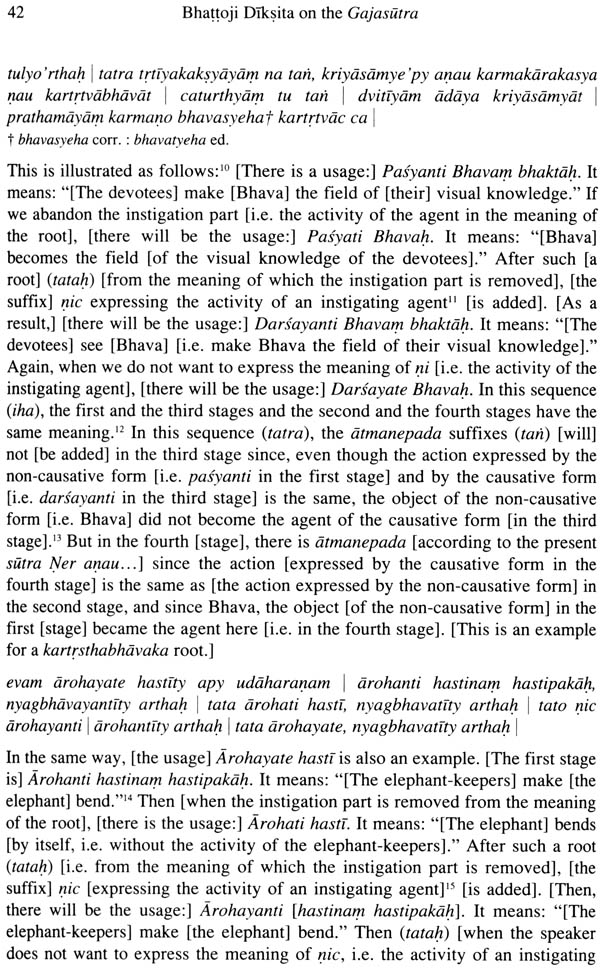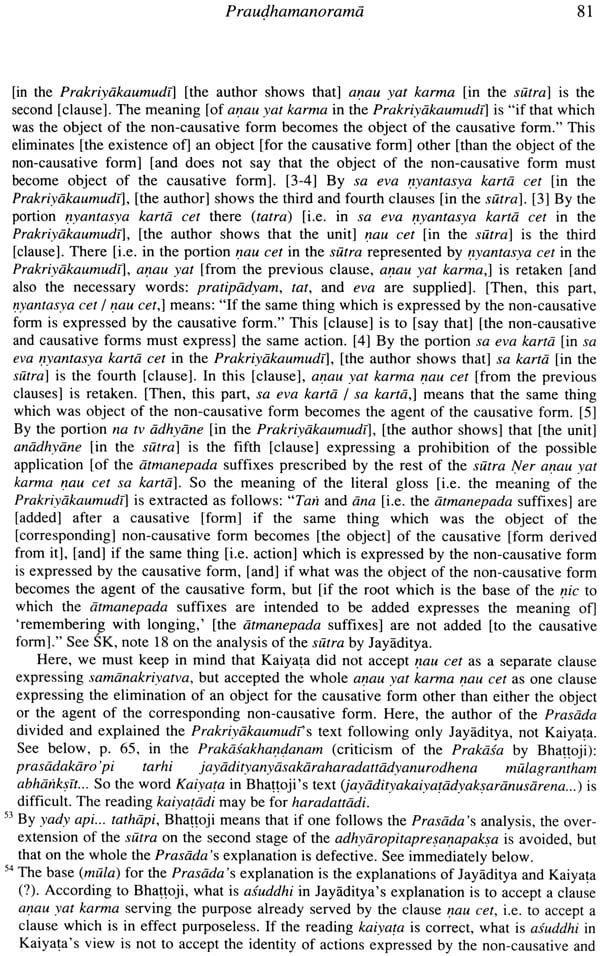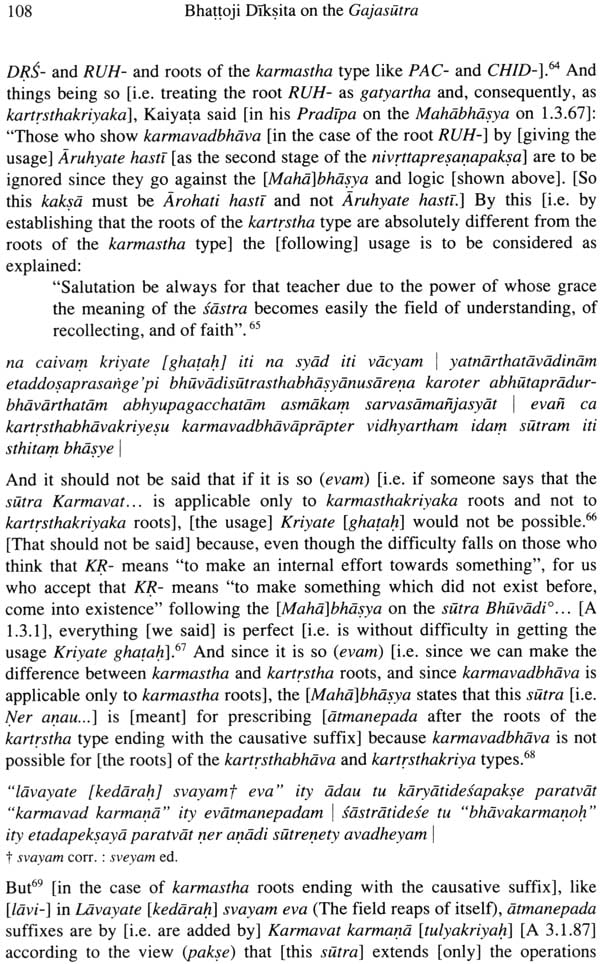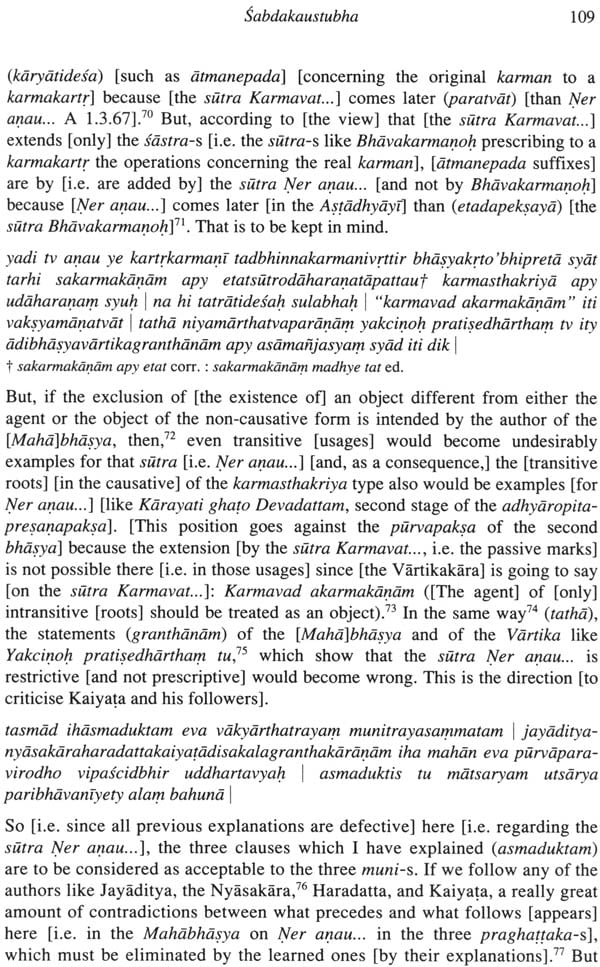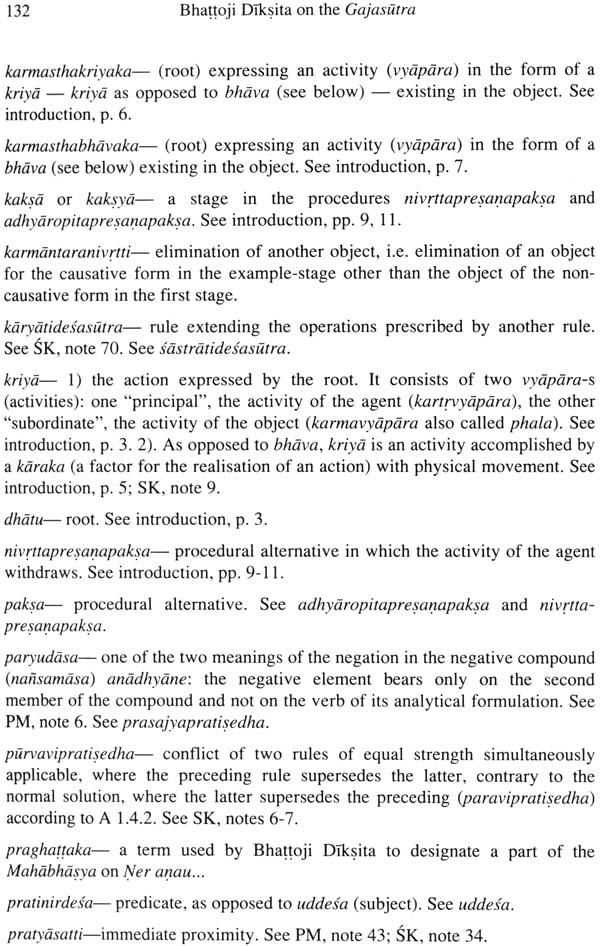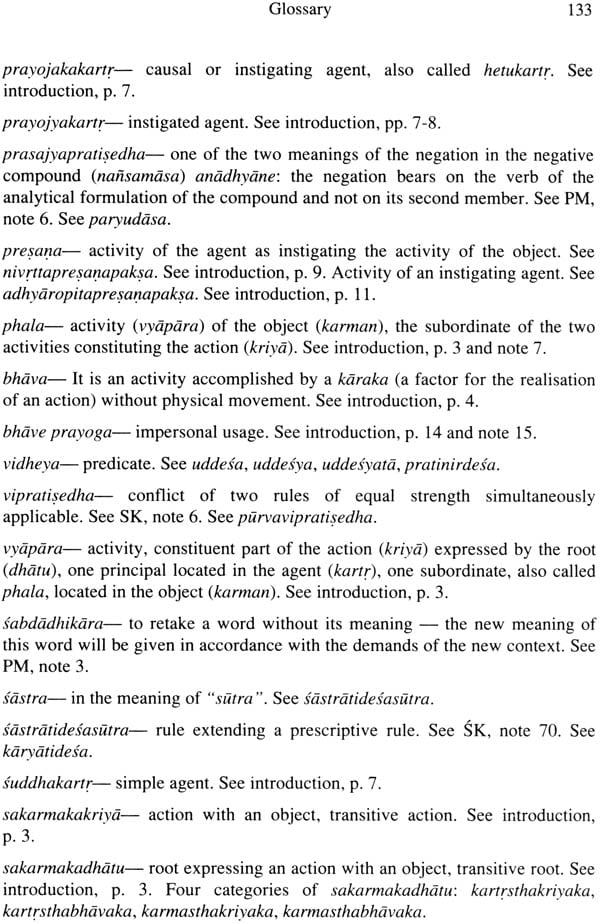
Bhattoji Diksita on The Gajasutra
Book Specification
| Item Code: | NAK787 |
| Author: | S.L.P. Anjaneya Sarma |
| Publisher: | Institut Francais De Pondichery |
| Language: | English |
| Edition: | 2013 |
| ISBN: | 9788184701968 |
| Pages: | 143 |
| Cover: | Paperback |
| Other Details | 9.5 inch x 6.5 inch |
| Weight | 270 gm |
Book Description
The Present volume intends to be the first of a series under the General title of Vyakhyanamala (A Garland of Commentaries). The purpose of this series is to illustrate and explain the genre of commentary as an integral part of Sanskrit intellectual history. The works chosen will belong to different domains: sastra, that is grammatical, poetic, and other technical literature as well as kavya, the Sanskrit genre of belles lettres. In the end, this series hopes to include commentaries of different types from different regions and times. These commentaries can be on a single source text – as in the case of the present volume- or can center around the explanation of a specific topic. The criterion for "commentary" is a deep engagement with a problematic text or concept. The prerequisite for inclusion in this series is that the commentaries must be previously untranslated.
The present volume offers a glimpse into early modern commentaries in the field of vyakarana, the discipline of grammar. The selection at hand is comprised of three commentaries of Bhattoji Diksita, the 17th century Maharastrian Brahmin writing in Benares, on the sutra 1.3.67 of the Astadhyayi , often called the Gajasutra after the elephants that features so prominently in its examples. The present authors have chosen these specific commentaries on this particular sutra since they are exemplary in regard to their subject; Bhattoji's analysis and interpretation of the sutra both take up the subtleties of Bhattoji's position- often in critical ways. Furthermore, the method and style of his commentaries here reproduced and translated are in many ways emblematic of the style of early modern Sanskrit intellectuals.
The present volume intends to be the first of a series under the general title of Vyakhyanamala. The purpose of this series is to illustrate and explain the genre of commentary as an integral part of Sanskrit intellectual history. These commentaries can be on a single source text (as in the case of the present volume) or can center around the explanation of a specific topic. The criterion for "commentary" is a deep engagement with a problematic text or concept.
The works chosen will belong to different domains: Sastra, that is grammatical, poetic, and other technical literature as well as kavya, the Sanskrit genre of belles lettres. In the end, this series hopes to include commentaries of different types from different regions and times so that a reader of Sanskrit intellectual history might possess a relatively representative sample of the commentarial genre. For all the work that has been put into understanding the form of various sorts of texts from the point of view of both modern and traditional scholars, very little work has been done on the sorting out the various strands and styles of commentary. Forms of commentary like vrtti and tika (often used in the titles of commentarial works) are sometimes theorized within Sanskrit texts, but rarely have the actual workings of commentarial texts bearing those titles been investigated in terms of their contents and structure. This series aims to understand what commentaries actually do and how they do it.
The prerequisite for inclusion in this series is that the commentaries must be previously untranslated. In the present volume, the Siddhdntakaumudi is included since its understanding is necessary to read the Praudhamanorama (which is itself a commentary on the previous text).
Each volume in this series will comprise of an introduction, the Sanskrit text, its translation, endnotes, and a glossary. The introductions will serve two purposes: first to provide an overview of the technical terms and concepts that are necessary to understand the text, and second to provide a summary of the arrangement and content of the texts translated themselves. This second purpose aims not only to provide a schematic outline, but also to investigate the formal characteristics of commentary as a genre. Such an outlook is necessary in order to understand the way in which a text is divided and arranged while further showing the way in which explanatory and argumentative thought is actually realized in the Sanskrit discourse.
The Sanskrit text of each commentary will appear before the translation. In general, the text is that of a previous printed edition. In this case the text is reproduced exactly as it appears in the printed version except in the case of obvious errors. The corrections are marked in the text as they appear and the rejected forms appear immediately below the Sanskrit text in a footnote. Sandhi and punctuation are always difficult issues in presenting Sanskrit. Here, we have tended to follow the printed editions, only adding or removing punctuation or sandhi when the text seemed difficult without an emendation. The text has been divided into paragraphs and sections according to our understanding. Paragraphs tend to contain one complete thought or argument, and we have tended to break the text into units that make sense as parts of the larger movement of the entire argument. As a final note on the presentation of the Sanskrit, the original always appears in Roman transcription rather than in Devanagari. This decision has been made to facilitate ease of reading (since there is only one script used in the book). The choice of Roman over Devanagari indicates that this book is primarily aimed toward a Western audience, however, we hope that the choice of script (since after all, Sanskrit does not have, or did not have until very recently a single unified method of writing) does not preclude this book being used and discussed by traditional scholars of Sanskrit in India as well.
The translation strives to be as literal as possible, however, when translating highly technical Sanskrit literature, it is often necessary to add words the author leaves implicit and explain ideas that the author expects to be common knowledge. We have put such additions in square brackets in order to facilitate the understanding of the reader and to make the necessary context absolutely explicit. Sanskrit words used in idiosyncratic or technical senses are placed in parentheses after the English translation. Further, it goes without saying that a commentary on a technical topic requires the use of many technical terms. They are translated as far as possible and in a form as short as possible. Taking for example the present work, a term like nyanta is translated as "causative verbal form" or "causative form." The terms that require a longer translation are only translated at the instance of their first (important) occurrence. For example, the two important terms for Bhattoji's commentary on the Gajasutra: nivrtta- presanapaksa (procedural alternative in which the activity of the agent withdraws) and adhyaropitapresanapaksa (procedural alternative in which the activity of an instigating agent is imposed). A list of the most important technical terms will be found in the glossary at the end of each volume.
The translation is accompanied by notes. These notes appear at the end of each respective commentary. In many places these notes simply serve to fill out references left implicit in the text or to define and discuss briefly the valences of a specific technical term. However, in many other cases the notes are meant to fill a pedagogical role. In the volume at hand for instance, the notes take the role of a teacher from the traditional perspective, walking through the points Bhattoji is making with reference to examples from accepted usage. The argumentation often follows both a positive and negative perspective; that is, the point will first be shown as leading to the accepted usage and then shown deficient if that particular form of reasoning is not followed. The notes may seem then to be attenuated, however this volume serves to reflect both an understanding of the text and an understanding of the argumentation that supports the text.
The notes are followed by a glossary of the most important technical terms used in the commentaries. The glossary is not an in depth explanation of these words, rather it hopes to serve as a memory aid, giving a brief translation of each term and a referral to the place in the volume (be it in the introduction, translation, or notes) where the term is most fully discussed.
The present volume offers a glimpse into early modern commentaries in the field of vyakarana, the discipline of grammar. The selection at hand is comprised of three commentaries of Bhattoji Diksita, the 17th century Maharastrian brahmin writing in Benares, on the sutra 1.3.67 of the Astadhyayi, often called the Gajasutra after the elephants that feature so prominently in its examples. The present authors have chosen these specific commentaries on this particular sutra since they are exemplary in regard to their subject; Bhattoji's analysis and interpretation of the sutra both take into account much previous scholarship on the sutra and lead later scholars to further discussions that take up the subtleties of Bhattoji's position - often in critical ways. Furthermore, the method and style of his commentaries here reproduced and translated are in many ways emblematic of the style of early modem Sanskrit intellectuals.
This book represents a part of the long collaboration between Dr. Anjaneya Sarma and Dr. Francois Grimal, both grammarians anxious to introduce primary sources of Paninian grammatical exegesis. It is in this context that the collaboration with Luther Obrock makes sense. Luther was the first student of this work and his comments and advice contributed greatly to its completion.
We are particularly grateful to Professor Jan E.M. Houben for his support and invaluable comments.
The three works of Bhattoji Diksita' presented here explain Panini's Astadhyayi (A). The Siddhantakaumudi (SK) makes its explanation through a new presentation of the sutra-s, in which they are rearranged according to topic. The Praudhamanorama (PM) then comments on the SK. The Sabdakaustubha (SK) also explains the A, but keeping the original order of the satra-s.2
Leaving aside the question as to how each of these works may be qualified as commentaries in and of themselves, there is no doubt that the extracts we reproduce, translate, and annotate here are commentaries. The texts of the SK and the SK belong to the genre of vrtti and at least the first part of the PM to the genre of tika.3 The first two texts in effect directly explain the sutra. In doing so, they follow the definition of vrtti,4 The extract from the PM comments indirectly on the sutra only at the beginning, since the first part explains, in the way a tika does, the commentary of the SK. Bhattoji devotes a second part of the extract from the PM to a criticism of the views of his predecessors on the said sutra.
The sutra in question is Ner anau yat karma nau cet sa kartanadhyane (A 1.3.67 / SK 2738), which prescribes the use of the atmanepada terminations after a causative verbal form under certain conditions. These conditions imply a series of transformations of an original iteration necessary to obtain the usages which are the examples for this sutra. In the final stage, the verbal form no longer has a causative meaning and, for Bhattoji, is intransitive. So by starting from Pasyanti Bhavam bhaktah (The devotees see Bhava), one can explain the usage Darsayate Bhavah (Bhava appears [to the devotees]).
The analysis of this sutra, at the core of which is this sequence of transformations, has been the subject of repeated discussions in the course of the history of the explanation of the A.5 Bhattoji's commentaries in the SK, the PM, and the SK give a significant overview of these different views which have been expressed before his time. Holding that they did not respect the understanding of the author of the Mahabhasya, the authority of whom he wants to reassert, Bhattoji must present them in order to criticize them.
From this point of view, these commentaries are essential to the understanding of the history and development of grammatical literature. Their importance is also due to the personality of their author and to the renown of his oeuvre, which remains authoritative even today.6
In order to facilitate the understanding of these commentaries, the first part of the introduction reviews the grammatical notions implied, and a second part presents an analysis and summary of these texts.
Grammatical notions for understanding the following commentaries
These are the notions of dhatu, kriya, vyapara, phala, sakarmakakriya and sakarmakadhatu, akarmakakriya and akarmakadhatu, bhava and kriya, the four categories of sakarmaka roots, the three types of kartr, the two procedures called the nivrttapresanapaksa and the dhyaropitapresanapaksa, and finally the notion of karmavadbhava.
Dhatu
A dhatu (root) is defined as expressing a kriya (action) and as belonging to a gana (group) (see A 1.3.1).
Kriya, vyapara, phala The kriya expressed by the dhatu consists of two vyapara-s (activities): one principal and one subordinate. The subordinate is also called phala (see below). Each of these two vyapara-s can also be called kriya. Each of these two activities must have a locus which is normally the kartr (the agent) and the karman (the object).
Sakarmakakriya and sakarmakadhatu
When these two activities have different loci - one being the agent and the other the object - the kriya is called sakarmakakriya (action with an object) and the root expressing this action is called sakarmakadhatu (transitive root).7 For example, the root DRS- in Pasyanti Bhavam bhaktah (The devotees see Bhava) expresses two activities: 1) to make someone or something become the field of visual perception (cakusajnanavisayibhavananukulavyapara) and 2) to become the field of visual perception (cakusajnanavisayibhavana). The first activity is principal, the second is subordinate. The second is called phala (fruit) since it is the product of the first, the principal activity. The locus of the principal activity expressed by the root is designated as kartr (agent) (pradhanibhutadhatvarthavyaparasrayah karta). The locus of the subordinate activity (phala) expressed by the root is designated as karman (object) (dhatvarthaphalasrayah karma).
Akarmakakriya and akarmakadhatu
When the two activities expressed by the root have the same locus, this locus must be the agent and therefore the root cannot have an object. In such a case, the kriya is called akarmakakriya (action without object) and the root expressing it is called akarmakadhatu (root without object, intransitive root).
| Foreword | i-iii |
| Introduction | 1-40 |
| Grammatical notions | 2-15 |
| An analysis and summary of the commentaries | 15-37 |
| Appendix | 38-40 |
| Siddhantakaumudi | 41-48 |
| Text and translation | 41-43 |
| Notes | 44-48 |
| Praudhamanorama | 49-89 |
| Text and translation | 49-68 |
| Notes | 69-89 |
| Sabdakaustubha | 91-129 |
| Text and translation | 91-112 |
| Notes | 113-129 |
| Glossary | 131-134 |
| Works Cited And Abbreviations | 135-136 |

